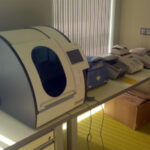Our laboratory was founded in 2003. Since that time we have continued to expand both in terms of personnel and equipment as well as the spectrum of performed methods.
Due to the quality of the instruments in our laboratory we are able to perform molecular genetic examinations in accordance with the latest diagnostic trends. We carry out detection of known mutations using PCR, or Real Time PCR and detection of mutations using direct sequencing to diagnose monogenic hereditary diseases. We also perform quick diagnostics of the most common aneuploidies from native amniotic fluid using multiplex QF PCR. We ensure transfer of the samples for DNA examination of various hereditary diseases to various departments in the Czech Republic, and if needed abroad.
We can offer determination of paternity (or maternity, parity) including expert opinions. The expert opinions are done at the request of the court, authorities involved in criminal proceedings and private persons.

Our laboratory is accredited according to ČSN EN ISO 15189.
We successfully take part in annual external quality audits.
Dokumenty
List of performed methods
QF-PCR (Quantitative Fluorescence Polymerase Chain Reaction) is a rapid diagnostic method detecting the most common aneuploidies and uniparental disomy of autosomes (13, 18, 21, 15, 16, 22) and sex chromosomes (X, Y). The analysis consists of detection of specific STR loci via PCR followed by fragmentation analysis using capillary electrophoresis.
Molecular-genetic examination using QF-PCR allows diagnosis of aneuploid genetic conditions including the Down, Edwards, Patau, Klinefelter, Turner, Jacob (supermale, XYY), triple X (superfemale, XXX) and polyploidy syndromes.
Examination of aneuploidies can be performed from the amniotic fluid, chorionic villi, fetal blood, and aborted fetal tissue. It is followed by cytogenetic examination of all chromosomes.
Indications for testing include: a positive atypical or borderline screening of first and second trimester, overall genetic risk to the fetus above 10%, abnormal ultrasound findings, combination of multiple risk factors
Cystic fibrosis (CF, mucoviscidosis) is a multisystem autosomal recessive genetic disorder whose classical form is manifested by respiratory and lung disease, pancreatic exocrine insufficiency, high concentration of electrolytes in sweat, and male reproductive disorder. The incidence of CF is 1:4500 in the Czech population, i.e. the carrier frequency is 1:34 (Votava F. et al., 2014). Cystic fibrosis is caused by mutations in the CFTR gene.
Our laboratory carries out an analysis that can detect 36 mutations and determine polymorphisms in intron 8 (Tn variants) of the CFTR gene. Mutations included in the test represent 91% of all causal CTFR mutations in the Czech population. If these mutations are not detected (negative CFTR test), the probability of carrying another mutation in the CFTR gene is reduced to 1:278 (0.36%). The test is suitable for both, the identification of asymptomatic carriers (heterozygotes) and the molecular-genetic diagnosis of affected individuals (homozygotes).
Indications for testing: subjects with CF symptoms, relatives of a patient suffering from CF and having detected CFTR mutations, couples where one partner carries a causal heterozygous mutation in the CFTR gene (testing before conception or during pregnancy), couples where both partners carry a causal heterozygous mutation in the CFTR gene (prenatal diagnosis), adult males with fertility disorders, preconception testing, gamete donors
Analysis of the AZF (azoospermia factor) region, which is located on the long arm of the Y chromosome (Yq) and is subdivided into AZFa, AZFb, and AZFc. Genes in the AZF region function in spermatogenesis and are essential for male reproduction. Depending on which of the azoospermia factors is absent, men develop oligozoospermia (reduced sperm count in the ejaculate) to azoospermia (absence of sperm in the ejaculate). Examination of sequence-tagged site (STS) markers on Yq detects about 90% of deletions in AZF regions.
Indications for testing include: male fertility disorder - poor spermiogram parameters
The aim of the examination is to detect the c.657-661del mutation, a deletion of five nucleotides, in the NBN gene. This mutation in the homozygous state causes the Nijmegen breakage syndrome (NBS), also known as Seemanova syndrome. NBS is a rare autosomal recessive DNA-repair disorder. It is a chromosome instability syndrome manifested by microcephaly, growth retardation, immunodeficiency, and predisposition to malignancy. Higher incidence of malignancies also affects heterozygous carriers. Patients with NBS are hypersensitive to ionizing radiation. The mutation c.657-661del is more common in the Slavic population, the frequency of carriers is 1:100-150.
Indications for testing: suitable for patients with clinical manifestations including microcephaly, chromosomal instability, growth retardation, increased frequency of malignancies in family history (especially lymphomas and leukemia), decreased serum IgG and IgA levels.
Haemochromatosis is an autosomal recessive disorder of iron storage that results in aberrant iron deposition in parenchymal cells. As the disease progresses, it leads to extensive tissue damage, diabetes mellitus, liver cirrhosis, hepatocellular carcinoma, heart failure, arthritis, and skin pigmentation. First symptoms often appear between the age of 40 and 50.
The test detects the most common mutations c.845G>A (C282Y) and c.187C>G (H63D) in the human HFE gene using allele-specific PCR. The examination is suitable for both, the identification of asymptomatic carriers (heterozygotes) and the molecular-genetic diagnosis of affected individuals (homozygotes).
Indications for testing: liver fibrosis or cirrhosis, cardiomyopathy, pancreopathy, diabetes, arthropathy, skin pigmentation.
Indications for testing:
- venous thrombosis (embolism) in an individual under 50 years of age
- thrombosis occurring in an unusual body part
- thromboembolic disease in a patient with a family history of thromboembolism
- thromboembolic disease in a patient with a family history of thromboembolism
- patient prior to scheduled surgery with a family history of thromboembolism
- a patient with recurrent miscarriages in the second or third trimester without a clear cause
- indication by a clinical haematologist
Indications for testing:
- prelingual hearing loss
- prelingual hearing loss in the family
- congenital hearing loss prior to cochlear implantation
- the presence of the mutation in consanguineous partners, or in newborns of incestuous relationships
- hearing relatives in families where the mutation has already been detected
The test detects HLA alleles predisposing to celiac disease. Examined alleles occur in more than 99% of patients with celiac disease and in 20% of healthy controls. The presence of predisposing alleles increases the risk of celiac disease fifty times compared to the general population.
Indications for testing:
- failure to thrive
- indigestion
- occurrence of celiac disease in the family
- anemia of unknown origin
The test detects the presence of the HLA-B27 allele. It is not recommended to use this examination to diagnose the ankylosing spondylitis in an asymptomatic population. The positive test (presence of HLA-B27 allele) indicates higher probability of AS occurrence, i.e. disease susceptibility, in a symptomatic individual. On the other hand, the negative test (absence of the HLA-B27 allele) may help rule out the AS in a clinically unclear patient.
Indications for testing:
Back pain, chronic pain or stiffness of the lower spine, reduced flexibility of the spine, chest pain during deep breathing, chronic fatigue, inflammation of the iris and ciliary body (iridocyclitis), less frequent symptoms: joint inflammation, pulmonary fibrosis, detachment of the nails from the nail bed.
Carriers of the premutation are not affected by intellectual disability, but the premutation causes presenile tremor and premature ovarian failure in women, thus exhibiting a low penetrance (in about 20% of female carriers of the premutation). Premutations are unstable during meiosis or early embryogenesis and if they are transmitted by a woman, there is a risk of expansion of CGG-repeat to the full mutation. On the other hand, premutations transmitted by males rarely expand into the full mutation. Intellectual disability caused by the full mutation mainly affects men, but the disease can also manifest itself in women. Approximately half of the female carriers of the full mutation have mild to moderate intellectual disability.
During the PCR test, we determine the number of CGG repeats in the FMR1 gene.
Indications for testing:
- psychomotor retardation, autism in personal or family history
- premature ovarian failure
- presenile tremor in men
During the examination, we detect the number of TA repeats in the TATA element and if a homozygous result of 7TA/7TA is found, we confirm the Gilbert syndrome.
Indications for testing:
- isolated mild hyperbilirubinemia (suspected GS)
- relatives with confirmed GS
- before taking irinotecan (GS represents a pharmacogenetic risk factor for irinotecan toxicity)
The examination is suitable for both, the identification of asymptomatic carriers (heterozygotes) and the molecular-genetic diagnosis of affected individuals (homozygotes).
Indications for testing:
- gastrointestinal upset after eating foods containing lactose
- differentiation of the primary type of lactase deficiency from the secondary type
- pathological lactose tolerance test or positive H2 breath test
- osteoporosis
Indications for testing:
- increased genetic risk of chromosomal aberration for the fetus (chromosomes 21,18, 13, X, Y)
- normal ultrasound findings while positive/borderline/atypical prenatal screening
- increased risk of complications when performing invasive diagnostics (CVS/AMC) because of higher genetic risk
- older age of pregnant woman (over 38 years)
- pregnancy via IVF, dysfertility, or sterility treatment
Hereditary cancers arise as a result of inherited mutations (disorders of genetic information in the DNA) of tumor predisposing genes, of which several hundred are known. The causal mutation is passed down from generation to generation in the affected family. The offspring can inherit it from the carrier parent in half of the cases. The presence of the causal mutation significantly increases the likelihood of developing cancer.
Early analysis of hereditary cancer predisposition is of particular importance for high-risk individuals and allows the inclusion of mutation carriers in preventive monitoring programs and consideration of possible prophylactic surgeries. The most common hereditary forms of tumors are breast, ovarian and colon tumors.
Hereditary breast and/or ovarian cancer syndrome is an autosomal dominant syndrome with incomplete penetrance. It is caused by causal (pathogenic) mutations, especially in tumor suppressor genes BRCA1 or BRCA2. In addition to the BRCA1,2 genes, the TP53, STK11, CDH1, PTEN, PALB2 genes are considered to be high-risk, while the ATM, CHEK2, NBN genes are considered to be at medium risk in connection with breast cancer. In ovarian cancer, the genes causal for Lynch syndrome (MLH1, MSH2, MSH6, PMS2) are high-risk, as well as the genes BRIP1, RAD51C and RAD51D.
Colon tumors can be divided into non-polyposis – Lynch syndrome (genes MLH1, MSH2, MSH6, PMS2, EPCAM, MUTYH) and adenomatous polyposis – FAP (APC gene).
In addition to breast, ovarian and intestinal tumors, heredity can also apply to tumors of the stomach, skin, pancreas, kidneys, and others.
Mutational analysis/screening of these genes allows confirmation of the genetic background of cancer development in affected individuals and subsequent predictive testing of their biological relatives. Asymptomatic carriers of the mutation are included in a follow-up program, which serves for prevention and early detection of cancer. For the mutation analysis we use the Czecanca panel (Czech cancer panel for clinical application), which was developed by the group of Doc. MUDr. Kleibl from the Institute of Biochemistry and Experimental Oncology of the 1st Faculty of Medicine of Charles University in Prague. The panel contains 226 target genes associated with hereditary malignancies that are analysed using Next Generation Sequencing (NGS). It includes known predisposing genes (approx. 69 genes) whose mutations cause hereditary cancers (e.g. ATM, APC, BARD1, BRCA1, BRCA2, BRIP1, CDH1, CHEK2, EPCAM, MLH1, MSH2, MSH6, MUTYH, NBN, PALB2, PMS2, PTEN, RAD50, RAD51C, RAD51D, STK11, TP53, CDKN2A, CDK4 etc). Other genes included in the panel represent candidate genes for preclinical studies within the Czech population.
Indications for testing:
- cancer at an unusually young age
- people with multiple types of cancer
- occurrence of bilateral tumors in paired organs
- recurrence of the same type of cancer in a family history (e.g. breast or colorectal cancer)
- combination of certain types of tumors (breast and ovarian cancer, colon, and uterine cancer) in close relatives, especially those with early onset of the disease
SMA is an autosomal recessive neuromuscular disease characterized by degeneration of the spinal horns and caused by a mutation in the SMN1 gene. More than 95% of patients carry a homozygous (biallelic) deletion of SMN1. In addition to the SMN1 gene, the highly homologous pseudogene SMN2 is located on the same chromosome (chromosome 5). Most of SMN2 transcripts lack exon 7 due to the 840C>T substitution. The SMN2 protein cannot prevent SMA, however it can mitigate its phenotype. Determining the number of copies of the SMN2 gene is important for SMA patients because the more copies a patient has, the milder the symptoms of the disease.
The examination is performed using the MLPA method that detects large deletions and duplications. We determine the copy number of exon 7 and 8 in both the SMN1 gene and the SMN2 pseudogene.
Indications for testing:
- gamete donors
- preconception examination
- individuals with neuromuscular disease
- families with SMA and relatives of already diagnosed SMA carriers



